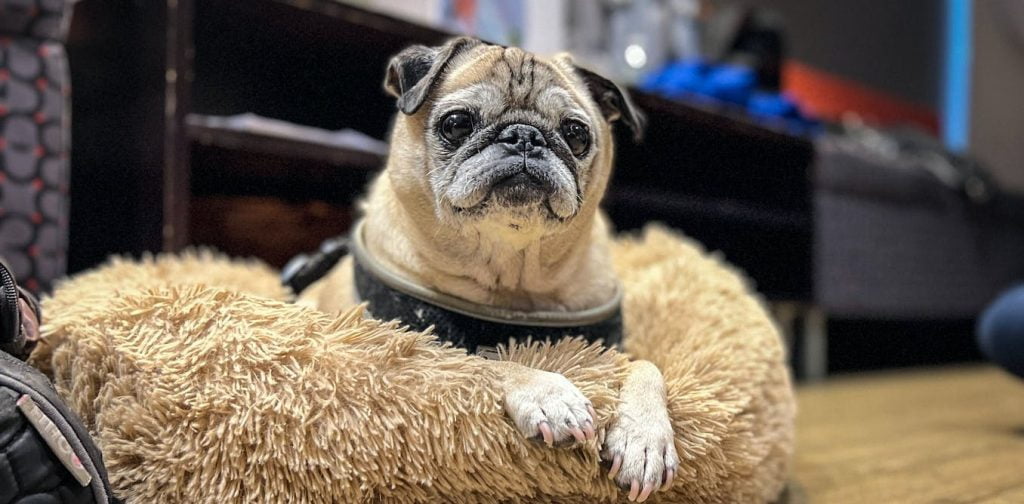On the 4th of December, TikTok user @jongraz announced his beloved pet, a pug named Noodle, had died aged 14. The announcement video received over 19 million views and 4 million likes, a testament to how widely loved Noodle was online.
Noodle and his owner Jonathan Graziano went viral on TikTok for their “Bones Day” routine. In the morning, Jonathan would film his attempts to lift Noodle out of bed. If Noodle stood up, it would be a Bones Day.
If he slouched back into bed, appearing to have no bones, it would be a No Bones Day. Jonathan would then give advice as to what kind of day viewers should expect to have, using Noodle’s Bones status as predictor of things to come.
For example, on a video with the caption “the prophet returns”, Jonathan tests Noodle and discovers it is a No Bones Day. He tells the viewers this “reading” means the audience has to be kind to themselves, they don’t have to do the dishes and are allowed to wear sweatpants for the rest of the day. Because Noodle said so.
The Bones Day phenomenon quickly became part of the Internet’s vernacular. The language spread into many online communities, and multiple TikTok musical artists made songs about Noodle. Noodle’s dad, along with illustrator Dan Travis, published a New York Times Bestseller book titled, Noodle and the No Bones Day
Noodle and Jonathan reached viral fame on TikTok one year into the pandemic, at time when many people were burnt out and experiencing deep loss. Fans online would use the Bones Day predictions as a sign of self care, coming together in the video comments to encourage Noodle and each other to rest and try again tomorrow.
Parasocial relationships and lost pets
Noodle’s death highlights the complex nature of online parasocial relationships. Introduced by Psychologists Donald Horton and R. Richard Wohl in 1956, this idea of a parasocial relationship describes when viewers of media have “an apparently intimate, face-to-face associations with a performer”.
Media scholar Janice Peck believes parasocial relationships are created when repeat contact with an online personality makes the viewer feel like they are talking to a friend. The intimate nature of how influencers share their lives online can make audiences feel closer to them. We are excited at their successes and can feel sadness when they are grieving.
If you have ever said that a celebrity’s behaviour was out of character, or felt like you understood a decision someone online was making, you might be experiencing a parasocial relationship. For example, the infamous trial between Johnny Depp and Amber Heard highlights how people eagerly take the side of one celebrity and condemn another. Shows like Love Island have incredibly strong fan attachments.
Parasociality, also called communicative intimacies by anthropologist and ethnographer Crystal Abidin, is negotiated through audience feedback, where audiences crave personal interactions – and influencers respond in kind. These kinds of relationships are common online and can also extend to pets.
There are currently millions of social media accounts dedicated to pets, many of these amassing large followings. Ester the Wonder Pig,Tuna the chiweenie, and Tikathe Italian Greyhound are some notable examples.
Pets and grief
Animal behaviourist Melissa Starling says that the loss of a pet can be deep and complex. While this grief is often invalidated by society by being seen as “lesser” than grief for a person, Starling argues it is important to recognise how the loss of a pet can be as painful as the loss of a human. Through the parasocial relationships that we form with pets like Noodle, it is not uncommon to grieve his death as we would our own pet or loved one.
Profound grief for a pet is normal – how to help yourself or a friend weather the loss of a beloved family member
Noodle is not the first beloved internet pet to pass away publicly. Earlier in the year Pot Roast, a famous cat on TikTok also died. The complex nature of the relationship between viewer and pet came to light as many fans of Pot Roast lashed out against her owner for the way she displayed her own grief.
One of the first famous pet’s death that reached headlines was the well-known Grumpy Cat, real name Tardar Sauce. Grumpy Cat amassed a massive online audience, and her owner created an entire brand around the cat’s signature grumpy face. This branding has continued long after the cat’s death.
Celebrating life after death
Users experiencing parasocial relationships, like the millions responding to Noodle’s death, use this relationship to show support and maintain relationships within online communities.
Since Noodle’s passing, thousands have posted videos memorialising his life, including other popular pet TikTok accounts like @mistermainer. @mistermainer’s video, which has over 750,000 views, is titled “Remembering an internet legend”. The video begins with close shot of the dog Maine before fading into clips of Noodle and his owner Jonathan, in a style reminiscent of funeral memorial videos.
Popular user @thechalkingdad posted a video tribute to Noodle by drawing his portrait in chalk. This video, with 1.7 million views, has soft background music, and a sombre voice over that says, “Goodbye Noodle, may every day be a bones day in heaven”.
Parasocial relationships with pets online are not only common, but can lead to very real feelings of grief. While grieving a pet may transgress the expected boundaries, these feelings are valid.
Noodle’s death reminds us of the deep, complex, and often very fulfilling relationships that users can form online. Relative strangers are able to connect over social media in a solidarity of mourning. Rather than grieving alone, they can use social media platforms to grief collectively.

